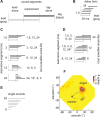Independence of echo-threshold and echo-delay in the barn owl
- PMID: 18974886
- PMCID: PMC2571984
- DOI: 10.1371/journal.pone.0003598
Independence of echo-threshold and echo-delay in the barn owl
Abstract
Despite their prevalence in nature, echoes are not perceived as events separate from the sounds arriving directly from an active source, until the echo's delay is long. We measured the head-saccades of barn owls and the responses of neurons in their auditory space-maps while presenting a long duration noise-burst and a simulated echo. Under this paradigm, there were two possible stimulus segments that could potentially signal the location of the echo. One was at the onset of the echo; the other, after the offset of the direct (leading) sound, when only the echo was present. By lengthening the echo's duration, independently of its delay, spikes and saccades were evoked by the source of the echo even at delays that normally evoked saccades to only the direct source. An echo's location thus appears to be signaled by the neural response evoked after the offset of the direct sound.
Conflict of interest statement
Figures







References
-
- Blauert J. Spatial Hearing: The Psychophysics of Human Sound Localization, Revised Edition. Cambridge, MA: The MIT Press; 1997.
-
- Haas H. Uber den einfluss eines einfachechos auf die horsamkeit von sprache [On the influence of a single echo on the intelligibility of speech]. Acustica. 1951;1:49–58.
-
- Litovsky RY, Colburn HS, Yost WA, Guzman SJ. The precedence effect. J Acoust Soc Am. 1999;106:1633–1654. - PubMed
-
- Wallach H, Newman EB, Rosenzweig MR. The precedence effect in sound localization. Am J Psychol. 1949;57:315–336. - PubMed
-
- Litovsky RY, Shinn-Cunningham B. Investigation of the relationship among three common measures of precedence: fusion, localization dominance, and discrimination suppression. J Acoust Soc Am. 2001;109:346–358. - PubMed
Publication types
MeSH terms
Grants and funding
LinkOut - more resources
Full Text Sources

